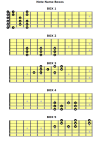This has worked for me as a set of shapes that one can memorize and track how they move around the neck. The shapes are consistent across modes with only the root locations changing in each shape per mode. Knowing interval locations on top of this takes it to anothet level. I can noodle around on the neck with this in any key/mode without having to really know the note names as I play them - I only need the to know the note name / location for the first note played to get myself started.
I'm also going to go wide on this one and say that learning every note on the neck isn't inherently going to make you a better guitar player.

No but it will stop me looking an idiot when my keyboard player asks me what on earth I'm playing
His ebook was called A.C.E. Guitar Method. The forum member who was giving it away was @JT2There was an ebook that a guy from this forum was giving away at one point. It was super helpful. I'll have to see if I can find it again.
